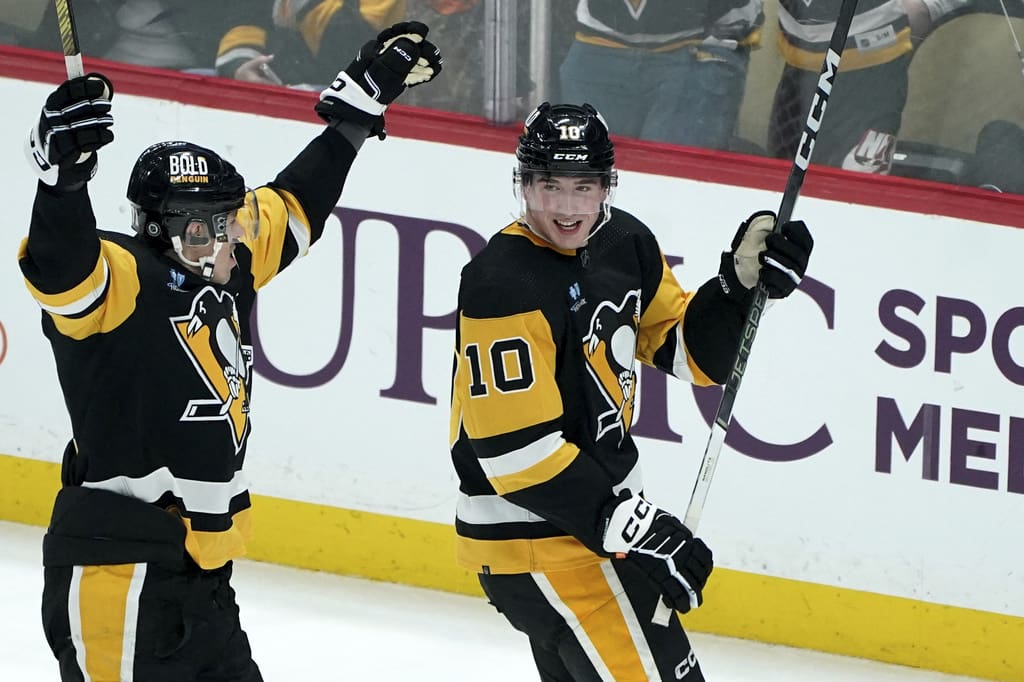Penguins
Penguins’ O’Connor Blossoms; How Malkin and Crosby Helped

There’s a long line of younger Pittsburgh Penguins who have gone through it – those eye-opening oh-bleep moments when they get a shot to play with Sidney Crosby or Evgeni Malkin. Some just can’t hang with them. Others have their career enhanced. Drew O’Connor fits in the latter category.
It’s not that O’Connor, who is blossoming into an established NHL player before our eyes, lacks his own skill set – using his speed, his 6-foot-3, 200-pound size and the reach that goes with it, and his nose for the puck.
However, while he has spent time in the bottom six, he also has gotten chances this season to play with the Penguins’ two superstar centers, filling in during injuries or being moved up for strategic purposes. He has been on Crosby’s right flank, on Malkin’s right flank and, for the past game-plus, on Malkin’s left flank as Reilly Smith, who has been struggling to produce, got moved to the third line.
Penguins coach Mike Sullivan said he liked the lineup he used against the Flyers because of its competitive balance.
Monday, O’Connor set up Malkin for the game’s final goal in an important 4-1 Penguins win over the Flyers in Philadelphia.
“I was just trying to take them wide, the two defensemen, and didn’t really have it, so I kind of curled up (the right half-wall) and just found a lane there, and he took it in and had a great shot,” O’Connor said, adding that playing the game with Malkin and right winger Bryan Rust was tough in the first period because of a lot of special teams, but “as it went along, we did some good things, had some good possessions.”
Playing with Crosby and Malkin have made O’Connor better, and his confidence seems to be soaring.
In an exclusive interview with PHN last month just after O’Connor crossed the career 100-game threshold, he talked about that.
Of course, he first trotted out the answer a thousand players have given over the years.
“I think I try to play the same way every game, regardless of who I’m playing with,” he said. “If they move me around the lines, like they’ve been doing, it’s not because they want me to change my style. I try to do the things that work, just try to play the same way and approach the game the same way.
“If I can win battles and get pucks to guys like that, I think, obviously, I can help them.”
O’Connor then conceded that playing with Malkin and Crosby is different. For one thing, there are those aforementioned oh-bleep moments when one second you’re skating and sizing things up, and the next second a pass from one of them is right there.
“I think you know that you’re going to get those chances,” O’Connor said. “Just try to be ready when they do find you and get you the puck. They see the ice so well. They have such good vision that they make those elite passes. You have to be ready for them at all times. You never know when they’re going to put it on your stick, so you just look for those opportunities and just be ready to make plays.”
Not everyone can. Some might fumble the pass or turn the puck over. That’s not an indictment, given the extraordinary skill of the two future Hall of Famers.
O’Connor is one of those players on the rise who has developed improved vision and timing by playing with Crosby and Malkin in those constant sink-or-swim moments. He has proven a quick study. He did, after all, attend an Ivy League school.
“I think watching them is one thing; when you’re on the ice with them, you kind of learn how they see the game a little differently and you try to pick things up like that,” he said. “So I think it’s been a good experience for me, just being on the ice with them and seeing how they see the ice differently.
“Yeah, just being ready at all times. You never want to be surprised when you get the puck on your stick. Just be alert, be ready at all times.”
That goes both ways. O’Connor has seemingly learned that he pretty much can’t surprise Crosby or Malkin with a feed. If he can get the puck in their vicinity – or in the vicinity where they will be in a second or two – they can usually get to it and often do something productive with it.
The Malkin goal he set up Monday gave O’Connor five goals, 14 points playing in all 39 games. He has three of those points over the past three games.
It might seem as if it has taken Drew O’Connor, 25, longer than expected or needed to become a full-fledged NHL player after he was up and down between the Penguins and AHL affiliate Wilkes-Barre/Scranton for three seasons, but, really, that’s not the case given his route.
He never played major junior hockey, went undrafted and played two seasons at Dartmouth before turning pro and signing with the Penguins in March 2020 – the pandemic year.
He was not signed by first-year president of hockey operations/general manager Kyle Dubas, but Dubas saw enough to offer O’Connor, a restricted free agent, a qualifying offer last summer. O’Connor filed for arbitration, but the sides settled on a two-year deal with a $925,000 cap hit before the scheduled arbitration hearing.
O’Connor has played all three positions and on each of the four lines at one time or another during his Penguins days. Perhaps he won’t stick in the top six permanently.
But he certainly seems capable if that’s how it works out or if he is needed for stretches of time. And that’s at least in part because he has gotten past those oh-bleep moments and gotten better while learning from the best.












